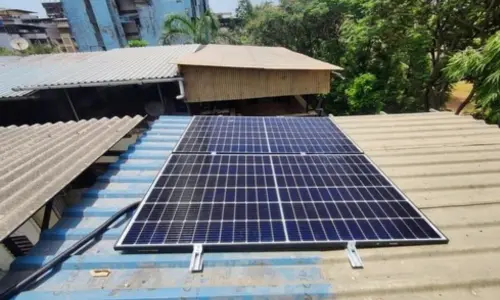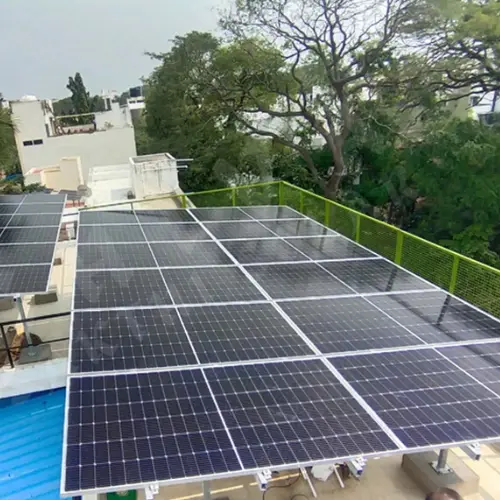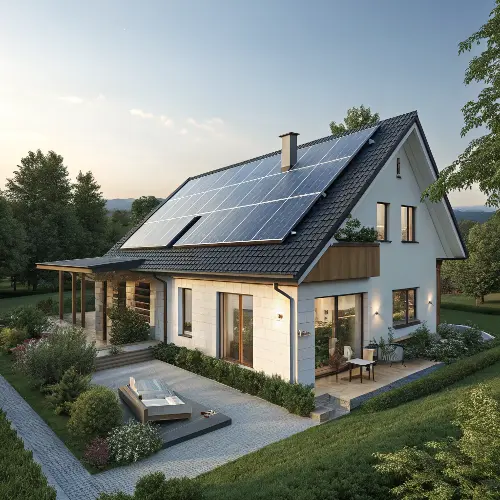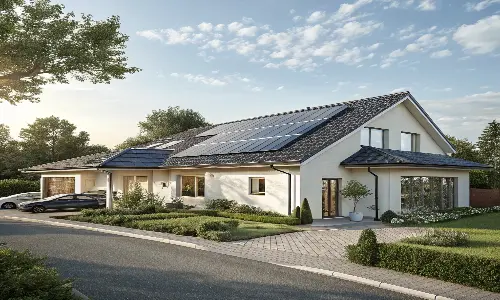1 kW Rooftop Solar System for Home in India

If you are looking for an affordable way to start using solar energy at home, a 1 kW rooftop solar system is the perfect entry point. Compact, budget-friendly, and reliable, it is designed to meet the basic electricity needs of a small household. With this system, you can easily power lights, fans, televisions, laptops, and charging devices—reducing your monthly electricity bills and dependence on the grid.
With India pushing for rooftop solar adoption under the PM Surya Ghar: Muft Bijli Yojana, more homeowners are choosing 1 kW solar systems to take the first step toward sustainable living.

Who Should Choose a 1 kW Rooftop Solar System?
A 1 kW solar panel system is most suitable for:
Small homes or apartments with 1–2 family members.
Households with basic daytime power needs (lights, fans, TV, laptops).
Homes with limited rooftop space (60–100 sq. ft).
Homeowners looking for a low-investment solar option before upgrading to higher capacities.
If your home runs multiple air-conditioners, geysers, or heavy appliances, a 2 kW–5 kW system will be more suitable.
Benefits of Installing a 1 kW Rooftop Solar System at Home
Cost savings
Reduce or eliminate electricity bills.
Government support
Avail subsidies and net metering benefits.
Eco-friendly
Reduces ~1.5 tons of CO₂ annually.
Energy independence
Protects against rising tariffs.
Increased property value
Homes with solar attract higher demand.


Installation Cost for Residential Rooftop Solar (1 kW)
Installation and BOS (balance of system) costs include:
- Solar mounting structures (GI/Aluminium)
- Cabling & conduits
- Earthing & lightning protection
- Labour & commissioning
Average installation cost for a 1 kW rooftop solar system is ₹10,000–₹15,000, depending on roof type and location.
1 kW Home Rooftop Solar System Price in India
System Type | Price Range | With Subsidy | Suitable For |
| On-Grid | ₹60k–₹80k | ₹35k–₹50k | Homes with reliable grid power, net metering |
| Off-Grid | ₹90k–₹1.2L | Subsidy not available | Homes with frequent power cuts |
| Hybrid | ₹1.1L–₹1.4L | Limited subsidy | Homes needing backup + grid connection |
Technical Specifications
| Components | Specification |
| Solar Panels | 3–4 panels (330–400 W each), Poly/Mono PERC |
| Inverter | 1 kW on-grid / off-grid / hybrid inverter |
| Battery (if off-grid) | 2 × 150 Ah (12 V) |
| Mounting | GI/Aluminium rooftop structure |
| Output | 1,400–1,500 units/year |
| Lifespan | Panels: 25 years, Inverter: 8–10 years, Battery: 5–6 years |
Savings & Power Output of a 1 kW Home Rooftop Solar
- Daily generation: 4–5 units
- Monthly generation: 120–150 units
- Annual generation: 1,400–1,500 units
- This can save ₹10,000–₹12,000 per year on electricity bills (assuming ₹7–₹8/unit tariff).
Area Required for 1 kW Rooftop Solar System
A 1 kW rooftop system requires 80–120 sq. ft. of shadow-free roof space.
- Orientation: South-facing with tilt angle equal to latitude.
- Compatibility: Works on concrete, metal sheet, or tiled roofs with the right mounting.
Subsidy for 1 kW Home Rooftop Solar
Under the PM Surya Ghar Yojana (2024-25):
- ₹30,000 subsidy for 1 kW rooftop systems.
- ₹60,000 subsidy for 2 kW, and up to ₹78,000 for 3 kW.
- This brings down the net cost of a 1 kW on-grid system to just ₹25,000–₹35,000 in many states.
Payback Period & ROI
- Net Investment (with subsidy): ₹30,000–₹35,000.
- Annual savings: ₹9,000–₹12,000.
- Payback: 3–4 years.
- System life: 25 years → ROI of 7–10x the initial investment.
Components of a 1 kW Rooftop Solar System
A standard 1 kW residential solar system includes:
- Solar Panels: 2–4 high-efficiency mono/mono-PERC/polycrystalline panels (300–420 W each).
- Inverter: 1 kW inverter (on-grid, off-grid, or hybrid).
- Mounting Structures: GI/Aluminium frames to secure panels on RCC or metal sheet roofs.
- Wiring & Protections: Cables, junction boxes, MCBs, SPD, and earthing kits.
- Battery (optional): 2 × 150 Ah batteries (if backup is needed).
All components should be MNRE-approved & BIS-certified for subsidy eligibility.
Installation Process (How We Do It)
- Site Survey – Shade/space/orientation check
- Design & BoM – Panel layout, structure, protections, cable sizing
- Approvals – Net-metering/subsidy application (where applicable)
- Installation – Structure, paneling, inverter, wiring, earthing
- Testing & Commissioning – Safety checks, app setup, handover
- Documentation – Warranty cards, test reports, O&M guide
Customer Review
“I installed a 1 kW solar rooftop system for my home, and the results have been impressive. My monthly electricity bill has dropped by almost 40%, and with net metering the extra power goes back to the grid. The panels need only simple cleaning every few weeks, and I haven’t faced any major maintenance issues so far. The subsidy was processed within a month of commissioning, which made the investment even more worthwhile. The only delay I experienced was during the meter replacement and DISCOM approval, but once that was sorted, the system has been running smoothly. Overall, I’m very satisfied as it not only saves money but also gives me reliable power during frequent cuts and helps me contribute to a greener environment.”
Why Choose Us for Your Home Rooftop Solar?
MNRE-approved installer with years of expertise
End-to-end service: design, subsidy application, installation, maintenance
High-quality Tier-1 solar panels and BIS-certified inverters
Transparent pricing with subsidy guidance
FAQs
What is the cost of a 1 kW rooftop solar system for home?
₹40,000–₹70,000 depending on type. With subsidy, on-grid can be ~₹25,000–₹35,000.
How many units will a 1 kW system generate?
~3–5 units/day; ~1,100–1,800 units/year (location & shading dependent).
How much roof space is required?
About 60–100 sq ft of shadow-free area with proper tilt.
Can I get subsidy for 1 kW?
Yes—typically ~₹30,000 under PM Surya Ghar (check your state portal for current slab).
Will the system work during power cuts?
On-grid: No (safety anti-islanding). Hybrid with battery: Yes (for selected loads).
What maintenance is needed?
Periodic cleaning (2–4 weeks) and one annual service. Keep strings, SPD, earthing in check.
Can I expand later to 2–3 kW?
Yes—plan structure/inverter accordingly or add parallel strings/micro-inverters.
